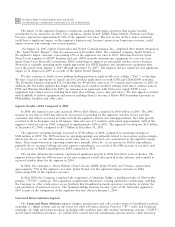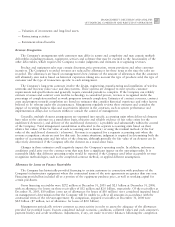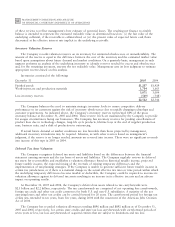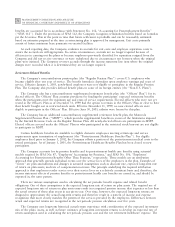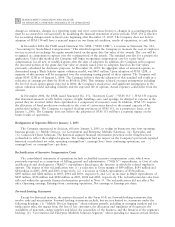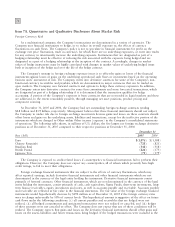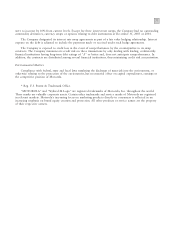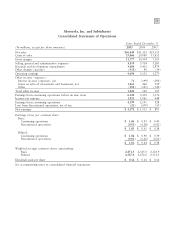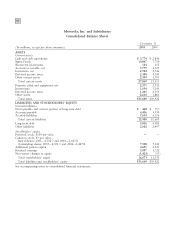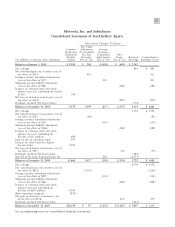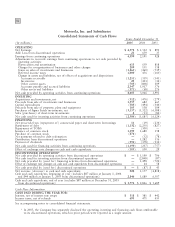Motorola 2005 Annual Report Download - page 79
Download and view the complete annual report
Please find page 79 of the 2005 Motorola annual report below. You can navigate through the pages in the report by either clicking on the pages listed below, or by using the keyword search tool below to find specific information within the annual report.
72 MANAGEMENT'S DISCUSSION AND ANALYSIS
OF FINANCIAL CONDITION AND RESULTS OF OPERATIONS
changes in estimates, changes in a reporting entity and error corrections; however, changes in accounting principles
must be accounted for retrospectively by modifying the financial statements of prior periods. SFAS 154 is effective
for accounting changes made in fiscal years beginning after December 15, 2005. The Company does not believe
adoption of SFAS 154 will have a material impact on our financial condition, results of operations, or cash flows.
In December 2004, the FASB issued Statement No. 123R (""SFAS 123R''), a revision to Statement No. 123,
""Accounting for Stock-Based Compensation.'' This standard requires the Company to measure the cost of employee
services received in exchange for equity awards based on the grant date fair value of the awards. The cost will be
recognized as compensation expense over the vesting period of the awards. The standard provides for a prospective
application. Under this method, the Company will begin recognizing compensation cost for equity based
compensation for all new or modified grants after the date of adoption. In addition, the Company will recognize
the unvested portion of the grant date fair value of awards issued prior to adoption based on the fair values
previously calculated for disclosure purposes. At December 31, 2005, the aggregate value of unvested options, as
determined using a Black-Scholes option valuation model, was $467 million. Upon adoption of SFAS 123R, a
majority of this amount will be recognized over the remaining vesting period of these options. The Company will
adopt SFAS 123R as of January 1, 2006. The Company believes that the adoption of this standard will result in a
reduction of earnings per share by $0.06 to $0.08 in 2006. This estimate is based on many assumptions including
the level of stock option grants expected in 2006, the Company's stock price, and significant assumptions in the
option valuation model including volatility and the expected life of options. Actual expenses could differ from the
estimate.
In November 2004, the FASB issued Statement No. 151, ""Inventory Costs'' (""SFAS 151''). SFAS 151 requires
that abnormal amounts of idle facility expense, freight, handling costs, and spoilage, be charged to expense in the
period they are incurred rather than capitalized as a component of inventory costs. In addition, SFAS 151 requires
the allocation of fixed production overheads to the costs of conversions based on the normal capacity of the
production facilities. The Company is required to adopt provisions of SFAS 151, on a prospective basis, as of
January 1, 2006. The Company does not believe the adoption of SFAS 151 will have a material impact on the
future results of operations.
Realignment of Segments Effective January 1, 2005
The Company announced its decision, effective January 1, 2005, to realign its businesses into four operating
business groups: (i) Mobile Devices, (ii) Government and Enterprise Mobility Solutions, (iii) Networks, and
(iv) Connected Home Solutions. The historical segment financial information presented in the filing has been
reclassified to reflect the realigned segments. The realignment had no impact on the Company's previously-reported
historical consolidated net sales, operating earnings(loss), earnings(loss) from continuing operations, net
earnings(loss) or earnings(loss) per share.
Reclassification of Incentive Compensation Costs
The consolidated statements of operations include reclassified incentive compensation costs, which were
previously reported as a component of Selling, general and administrative (""SG&A'') expenditures, to Cost of sales
and Research and development (""R&D'') expenditures based upon the function in which the related employees
operate. The impact of this reclassification was: (i) a reduction in Gross margin of $89 million, $143 million and
$64 million in 2005, 2004 and 2003, respectively, (ii) a decrease in SG&A expenditures of $334 million,
$495 million and $244 million in 2005, 2004 and 2003, respectively, and (iii) an increase in R&D expenditures of
$245 million, $352 million and $180 million in 2005, 2004 and 2003, respectively. The reclassification has also been
reflected within the quarterly financial information provided in Note 15. The reclassifications did not affect Net
sales, Operating earnings, Earnings from continuing operations, Net earnings or Earnings per share.
Forward-Looking Statements
Except for historical matters, the matters discussed in this Form 10-K are forward-looking statements that
involve risks and uncertainties. Forward-looking statements include, but are not limited to, statements under the
following headings: (1) ""Mobile Devices Segment,'' about industry growth, including in emerging markets and for
replacement sales, the impact from the loss of key customers, the allocation and regulation of frequencies the
availability of materials, energy supplies and labor, the seasonality of the business, and the firmness of the segment's
backlog; (2) ""Government and Enterprise Mobility Solutions Segment,'' about spending for mission-critical wireless




